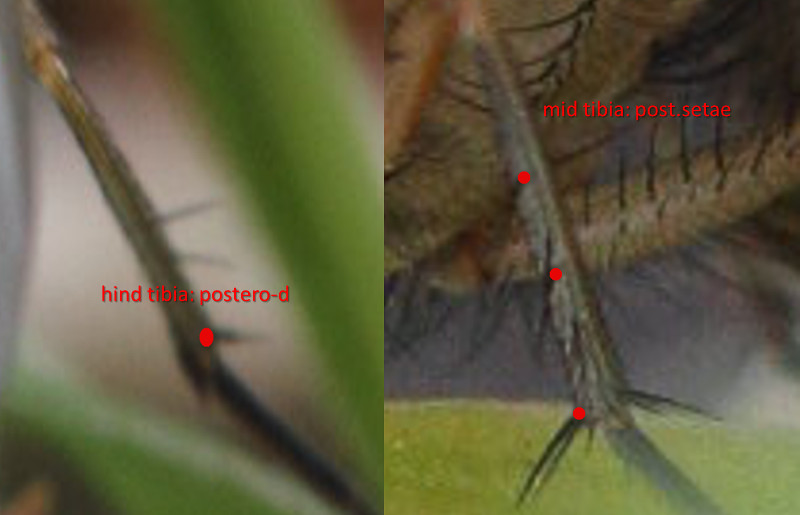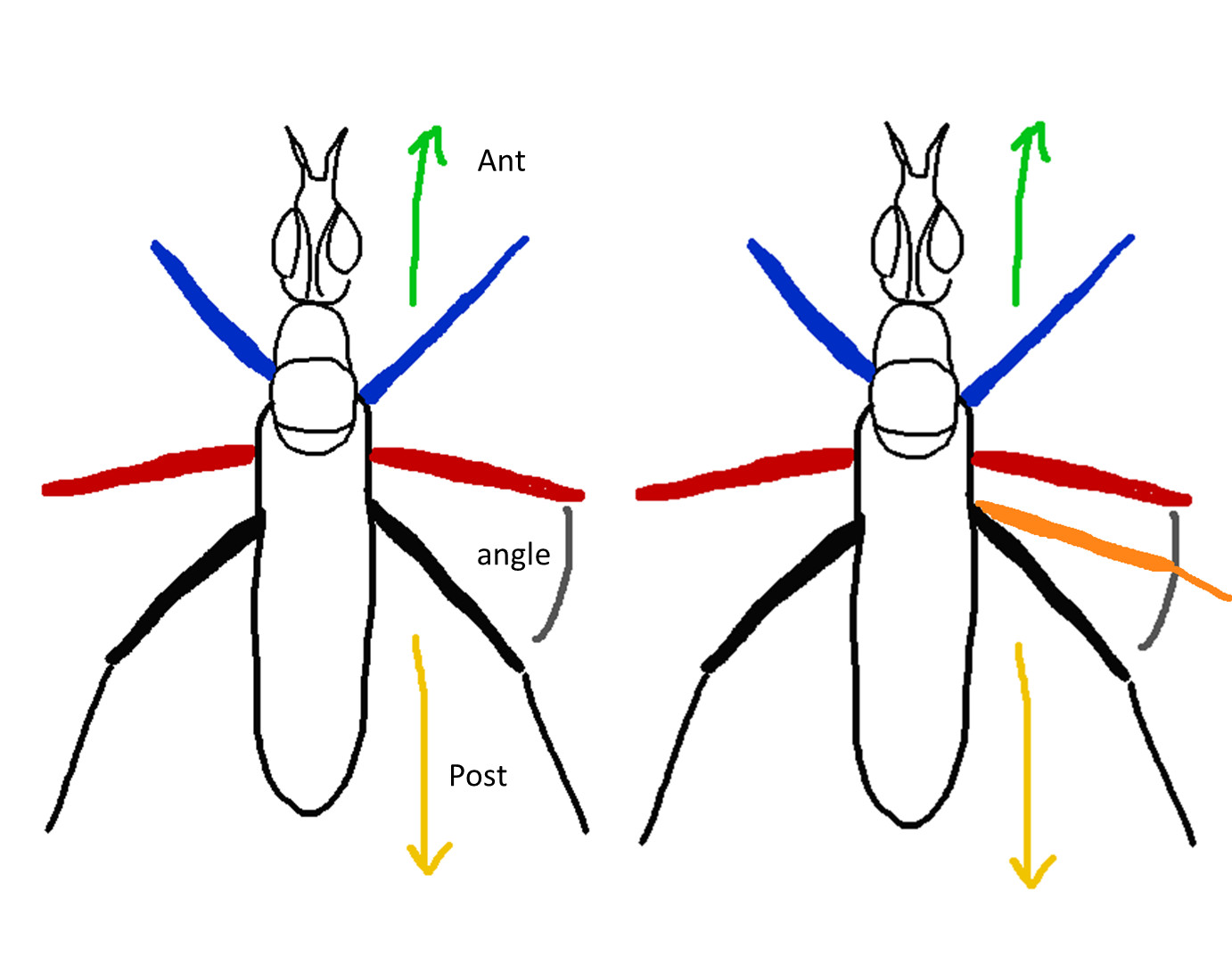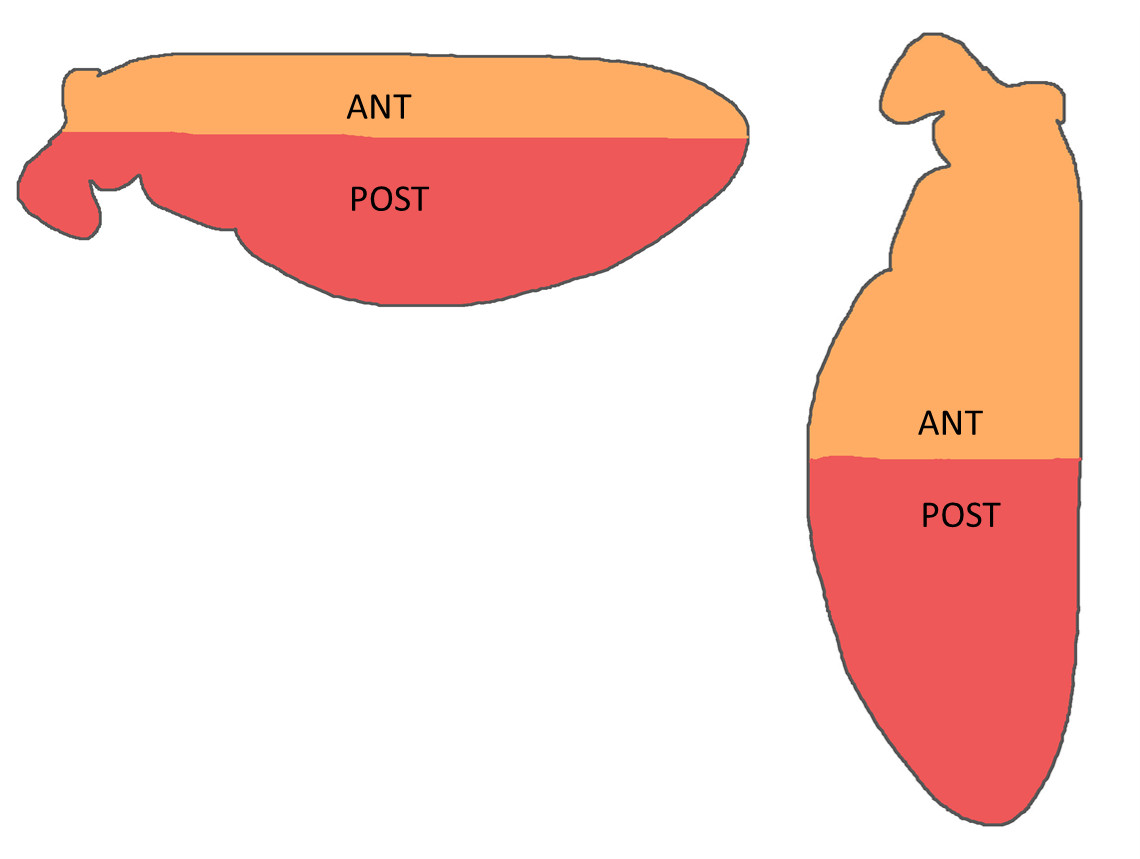| Autore |
 Discussione Discussione  |
|
mbondini
Utente Super
    
Città: Agugliano
Prov.: Ancona
Regione: Marche

5810 Messaggi
Tutti i Forum |
|
|
ValerioW
Moderatore
    

Città: Padova
Prov.: Padova
Regione: Veneto

8059 Messaggi
Tutti i Forum |
 Inserito il - 18 maggio 2014 : 11:12:29 Inserito il - 18 maggio 2014 : 11:12:29


|
 maschio di Phaonia . In questo momento non riesco a dirti di più, dato che ha un colore particolarmente spento. Se non fosse per le antenne così scure e senza peli, avrei ipotizzato frettolosamente P. pallida con colorazione inusuale. maschio di Phaonia . In questo momento non riesco a dirti di più, dato che ha un colore particolarmente spento. Se non fosse per le antenne così scure e senza peli, avrei ipotizzato frettolosamente P. pallida con colorazione inusuale.
|
爱 自 然 |
Modificato da - ValerioW in data 18 maggio 2014 11:24:28 |
 |
|
|
chlorophana
Utente Senior
   
Regione: France

1186 Messaggi
Flora e Fauna |
 Inserito il - 18 maggio 2014 : 18:27:54 Inserito il - 18 maggio 2014 : 18:27:54


|
No "Phaonia seta" qui : è una Helina.
Difficult to ID since the fly is rather young : one can see it by the coloration not fully developped, the wings with a "milky" aspect. The fly could well be darker in the next hours.
Quindi Helina sp.
Stéphane. |
|
 |
|
|
ValerioW
Moderatore
    

Città: Padova
Prov.: Padova
Regione: Veneto

8059 Messaggi
Tutti i Forum |
 Inserito il - 18 maggio 2014 : 19:32:35 Inserito il - 18 maggio 2014 : 19:32:35


|
| Messaggio originario di chlorophana:
No "Phaonia seta" qui : è una Helina.
Stéphane.
|
Which "seta" are you talking about? |
爱 自 然 |
Modificato da - ValerioW in data 18 maggio 2014 19:54:16 |
 |
|
|
ValerioW
Moderatore
    

Città: Padova
Prov.: Padova
Regione: Veneto

8059 Messaggi
Tutti i Forum |
 Inserito il - 18 maggio 2014 : 19:38:36 Inserito il - 18 maggio 2014 : 19:38:36


|
| I see the posterodorsal seta in the apical half of hind tibia, typical of Phaonia (except P. latifrontalis), and also 2 posterior seatae on mid tibia. |
爱 自 然 |
 |
|
|
ValerioW
Moderatore
    

Città: Padova
Prov.: Padova
Regione: Veneto

8059 Messaggi
Tutti i Forum |
 Inserito il - 18 maggio 2014 : 19:44:40 Inserito il - 18 maggio 2014 : 19:44:40


|
images about legs' setae:
-left photo: hind tibia
-right photo: mid tibia
This characters are considered important by R. Rozkosny
Immagine:

64,11 KB |
爱 自 然 |
 |
|
|
chlorophana
Utente Senior
   
Regione: France

1186 Messaggi
Flora e Fauna |
 Inserito il - 18 maggio 2014 : 20:04:43 Inserito il - 18 maggio 2014 : 20:04:43


|
Valerio, postero = behind, you are pointing an anterodorsal seta on the hind tibia ! 5that's OK for the mid tibia though).
The "Phaonia bristle" is the posterodorsal seta in the distal third of hind tibia.
Another thing : in Muscidae, the preapical (and apical) bristles on tibiae are rarely of taxonomic importance (except some preapical pv which can be present in some Phaonia), and you should never count them in the total of setae : thus, in your second annoted picture, the mid tibia bears only 2 posterior setae (I think they are more than 2, but the picture is too blur). |
|
 |
|
|
ValerioW
Moderatore
    

Città: Padova
Prov.: Padova
Regione: Veneto

8059 Messaggi
Tutti i Forum |
 Inserito il - 18 maggio 2014 : 20:17:52 Inserito il - 18 maggio 2014 : 20:17:52


|
| No, the hind tibia is taken from the photo 3, and that seata is the postero-dorsal. Check the leg orientation, and you see that the whole posterior surface of the tibia is watching you; if you consider the anterior part North and antero-dorsal North-East, the seata I've signed points South-East, |
爱 自 然 |
 |
|
|
ValerioW
Moderatore
    

Città: Padova
Prov.: Padova
Regione: Veneto

8059 Messaggi
Tutti i Forum |
 Inserito il - 18 maggio 2014 : 20:22:33 Inserito il - 18 maggio 2014 : 20:22:33


|
| Messaggio originario di chlorophana:
Another thing : in Muscidae, the preapical (and apical) bristles on tibiae are rarely of taxonomic importance (except some preapical pv which can be present in some Phaonia), and you should never count them in the total of setae : thus, in your second annoted picture, the mid tibia bears only 2 posterior setae (I think they are more than 2, but the picture is too blur).
|
Thanks but, I just signed 2, because 2 are the minimum that Rozkosny said ("at least 2 posterior seatae on the mid tibia" cit. Rozkosny). I am still not convinced it's Helina. |
爱 自 然 |
 |
|
|
chlorophana
Utente Senior
   
Regione: France

1186 Messaggi
Flora e Fauna |
 Inserito il - 18 maggio 2014 : 20:44:04 Inserito il - 18 maggio 2014 : 20:44:04


|
I think I understand your mistake : you are confusing posterior with dorsal : your sentence would be :
| you see that the whole posterior dorsal surface of the tibia is watching you |
Then it becomes evident that the annoted setae from you are on the dorsal side, and oriented toward the front of the fly, so they are antero-dorsal.
Here is my drawing (not the best) :
Immagine:

91,33 KB |
|
 |
|
|
chlorophana
Utente Senior
   
Regione: France

1186 Messaggi
Flora e Fauna |
 Inserito il - 18 maggio 2014 : 20:55:29 Inserito il - 18 maggio 2014 : 20:55:29


|
Please, see also :
Link |
|
 |
|
|
ValerioW
Moderatore
    

Città: Padova
Prov.: Padova
Regione: Veneto

8059 Messaggi
Tutti i Forum |
 Inserito il - 18 maggio 2014 : 21:09:59 Inserito il - 18 maggio 2014 : 21:09:59


|
Thanks for the link! The picture is quite detailed
The orientation of the tibia you gave is different from the one I mentally realized, that should be look like this
Blu arrow: posterior, red arrow: anterior, red semi-circle: anterior-half, blu semi-circle: posterior half, and yellow line: seta
Immagine:

63,31 KB |
爱 自 然 |
 |
|
|
ValerioW
Moderatore
    

Città: Padova
Prov.: Padova
Regione: Veneto

8059 Messaggi
Tutti i Forum |
 Inserito il - 18 maggio 2014 : 21:17:52 Inserito il - 18 maggio 2014 : 21:17:52


|
| P.S.: About chaetotaxy details I also thave different books |
爱 自 然 |
 |
|
|
chlorophana
Utente Senior
   
Regione: France

1186 Messaggi
Flora e Fauna |
 Inserito il - 18 maggio 2014 : 21:29:43 Inserito il - 18 maggio 2014 : 21:29:43


|
| OK, your drawing precisely show the dorsal (in blue) and ventral(in red) parts of hind tibia. ;) |
|
 |
|
|
ValerioW
Moderatore
    

Città: Padova
Prov.: Padova
Regione: Veneto

8059 Messaggi
Tutti i Forum |
 Inserito il - 19 maggio 2014 : 08:12:53 Inserito il - 19 maggio 2014 : 08:12:53


|
It's not precise, otherwise the leg should be exactly aligned with the fly body  . .
Anyways Your remarks can be correct only if hind leg, in its natural position, is intrarotated toward the base of coxae II, just oriented in the same way... in this case, the anterior semicircle will coincide with a semicircle made with the right half of those that I already painted. But the problem is that in the resting position, posterior leg lays points behind, describing an acute angle with a line passing in the mid leg.
I made this ugly pic, using a Neriidae, hoping it will be useful to understand what I mean.
The hind legs are red, mid are black, fore blue. The orange leg is the position that the hind leg should maintain for being considered with the orientation you say. But this isn't a position I've ever seen with a resting fly.
Immagine:

119,82 KB |
爱 自 然 |
 |
|
|
ValerioW
Moderatore
    

Città: Padova
Prov.: Padova
Regione: Veneto

8059 Messaggi
Tutti i Forum |
 Inserito il - 19 maggio 2014 : 08:24:32 Inserito il - 19 maggio 2014 : 08:24:32


|
To explain it easier I try another example.
A diptera X has ALWAYS spread wing, so the ANT and POST side are as in the left picture I made.
A diptera Y has ALWAYS closed wing, so ANT and POST are as follows (right pic).
Ant and Post change.
This is an absurd example, but I think can be useful
Immagine:

54,61 KB |
爱 自 然 |
 |
|
|
ValerioW
Moderatore
    

Città: Padova
Prov.: Padova
Regione: Veneto

8059 Messaggi
Tutti i Forum |
 Inserito il - 19 maggio 2014 : 08:27:00 Inserito il - 19 maggio 2014 : 08:27:00


|
| ...in the normal anatomy of diptera I've always found hind legs oriented backward, and so considered it the "normal position" by which compare any specimen. |
爱 自 然 |
 |
|
|
ValerioW
Moderatore
    

Città: Padova
Prov.: Padova
Regione: Veneto

8059 Messaggi
Tutti i Forum |
 Inserito il - 19 maggio 2014 : 08:58:44 Inserito il - 19 maggio 2014 : 08:58:44


|
Mi è stato gentilmente chiesto da Vladim di tradurre, almeno sinteticamente, di cosa si sia discutendo esattamente.
Phaonia ed Helina sono entrambi generi della famiglia Muscidae, tra l'altro particolarmente simili tra loro.
Un dettaglio che è utile a distinguerli, e che io ho sfruttato nell'ID, è la presenza nella parte apicale della tibia posteriore di una setola, orientata postero-dorsalmente. Secondo Stephane l'orientamento che ho interpretato io come postero-dors. in realtà sarebbe antero-dorsale. L'ipotesi di Stephane, per essere corretta, richiederebbe che la zampa in posizione "anatomica"(cioè quella usata negli schemi dei testi), fosse orientata praticamente come la zampa media, che è quasi disposta in modo ortogonale rispetto all'asse longitudinale del corpo. Tuttavia io sto insistendo che non ho mai visto la zampa posteriore così ruotata anteriormente nell'animale a riposo (e sopratutto non lo è negli schemi anatomici) e uso diversi esempi per spiegare la cosa; un neride, con indicata in arancione la posizione che dovrebbe avere la zampa posteriore per risultare quanto dice Stephane, e un'ala di brachicero caliptrato per mostrare come le posizioni anteriore e posteriore possano essere diverse a seconda della posizione anatomica.
Faccio un esempio ancora più semplice in italiano. Una scimmia quadrumane, facendo finta abbia esattamente 4 mani uguali tra loro, ha, in posizione anatomica la parte anteriore delle mani superiori coincidente col palmo, mentre in quelle inferiori coincide ad esempio con la parte anteriore del tarso e con tutte le falangi.
Il dubbio che mi rimane è che in realtà, ant. e post. forse non siano legate solo all'orientamento del corpo, ma magari alla struttura della zampa stessa. In questo caso, si presincederebbe dal senso reale di anteriore e posteriore. E' come se le mani "inferiori" della scimmia, pur orientate come sappiamo (metà anteriore coincidente con parte di tarso e falangi), fossero considerate come le anteriori, col palmo coincidente con la parte anteriore, e il dorso con la posteriore.
Scusate questa discussione immensa, forse poco chiara, ma vorrei capire meglio la questione. |
爱 自 然 |
 |
|
|
ValerioW
Moderatore
    

Città: Padova
Prov.: Padova
Regione: Veneto

8059 Messaggi
Tutti i Forum |
 Inserito il - 19 maggio 2014 : 10:32:02 Inserito il - 19 maggio 2014 : 10:32:02


|
Last example, I hope  . left: the mental plan I'm using, and that is used, at least apparently, by dipterist's anatomic charts. right: the plan that can explain Stephane's descriptions, and that doesn't coincide with a directional point of view using the body longitudinal line as reference, but that depends upon structural anatomy. . left: the mental plan I'm using, and that is used, at least apparently, by dipterist's anatomic charts. right: the plan that can explain Stephane's descriptions, and that doesn't coincide with a directional point of view using the body longitudinal line as reference, but that depends upon structural anatomy.
I ask to Stephane if he is using the right one.
Immagine:

98,55 KB |
爱 自 然 |
 |
|
|
vladim
Moderatore trasversale
    

Città: Milano
Prov.: Milano
Regione: Lombardia

34172 Messaggi
Tutti i Forum |
 Inserito il - 19 maggio 2014 : 11:15:38 Inserito il - 19 maggio 2014 : 11:15:38


|
| Messaggio originario di ValerioW:
Mi è stato gentilmente chiesto da Vladim di tradurre, almeno sinteticamente, di cosa si sia discutendo esattamente.
Phaonia ed Helina sono entrambi generi della famiglia Muscidae, tra l'altro particolarmente simili tra loro.
Un dettaglio che è utile a distinguerli, e che io ho sfruttato nell'ID, è la presenza nella parte apicale della tibia posteriore di una setola, orientata postero-dorsalmente....
|
Grazie!
Non è facile, anzi , ma cercherò di studiarla con calma. , ma cercherò di studiarla con calma.  

|
 |
|
|
ValerioW
Moderatore
    

Città: Padova
Prov.: Padova
Regione: Veneto

8059 Messaggi
Tutti i Forum |
 Inserito il - 19 maggio 2014 : 11:19:04 Inserito il - 19 maggio 2014 : 11:19:04


|
| Messaggio originario di vladim:
| Messaggio originario di ValerioW:
Mi è stato gentilmente chiesto da Vladim di tradurre, almeno sinteticamente, di cosa si sia discutendo esattamente.
Phaonia ed Helina sono entrambi generi della famiglia Muscidae, tra l'altro particolarmente simili tra loro.
Un dettaglio che è utile a distinguerli, e che io ho sfruttato nell'ID, è la presenza nella parte apicale della tibia posteriore di una setola, orientata postero-dorsalmente....
|
Grazie!
Non è facile, anzi , ma cercherò di studiarla con calma. , ma cercherò di studiarla con calma.  

|
Grazie a te che mi hai fatto beccare il mio ennesimo refuso. *stia discutendo, non "sia discutendo" *stia discutendo, non "sia discutendo" |
爱 自 然 |
 |
|
 Discussione Discussione  |
|

 Forum
|
Registrati
|
Msg attivi
|
Msg Recenti
|
Msg Pvt
|
Utenti
|
Galleria |
Map |
Forum
|
Registrati
|
Msg attivi
|
Msg Recenti
|
Msg Pvt
|
Utenti
|
Galleria |
Map |